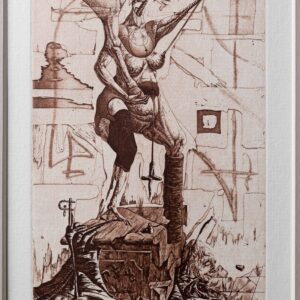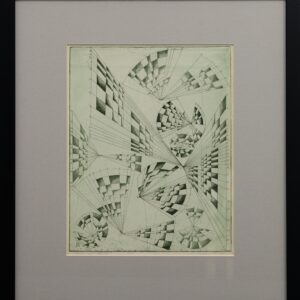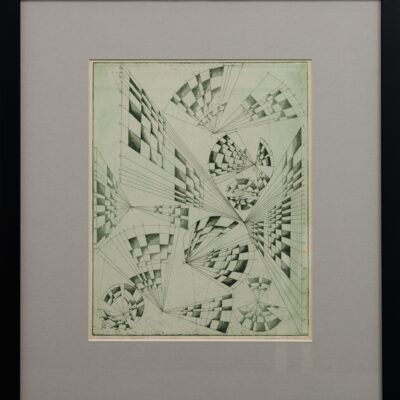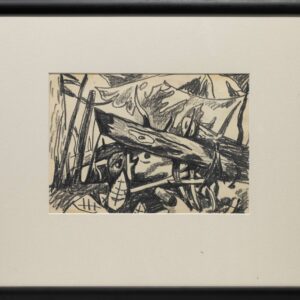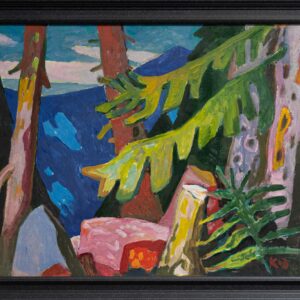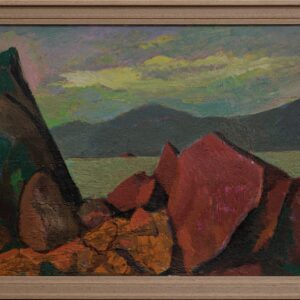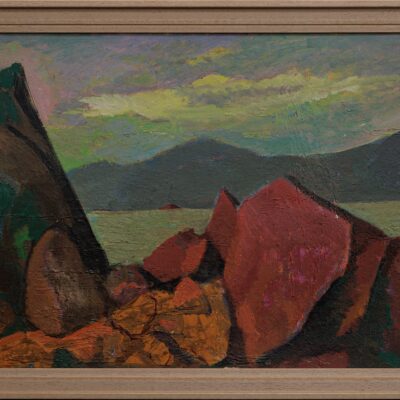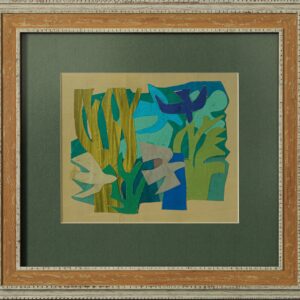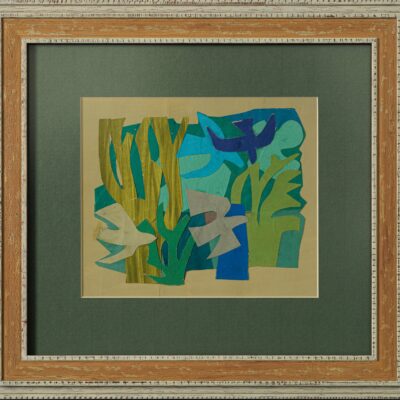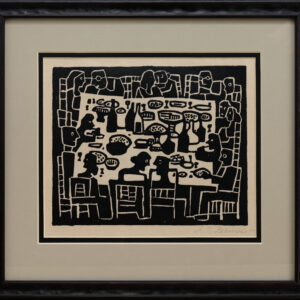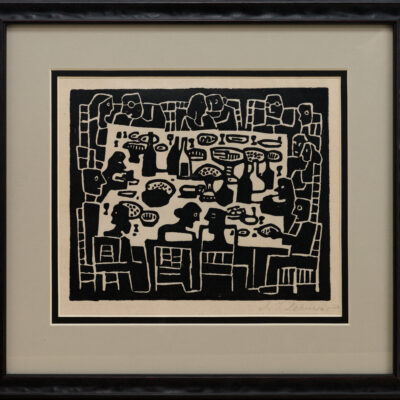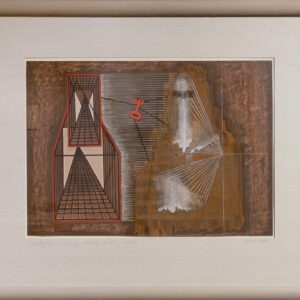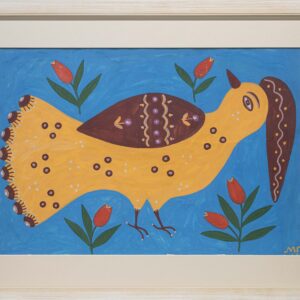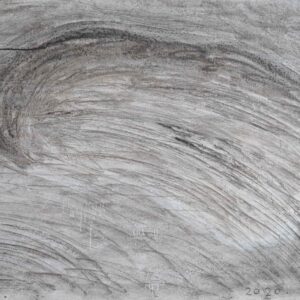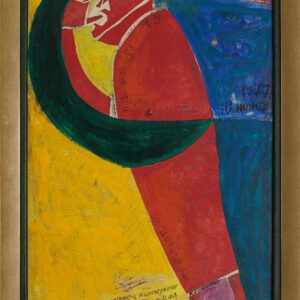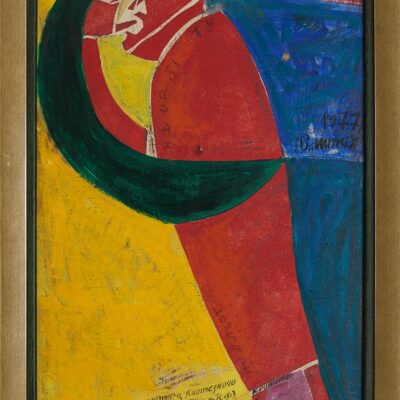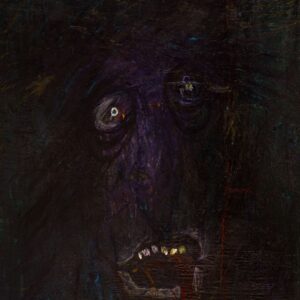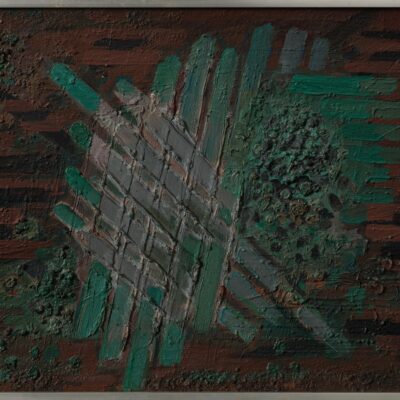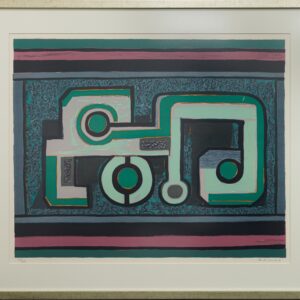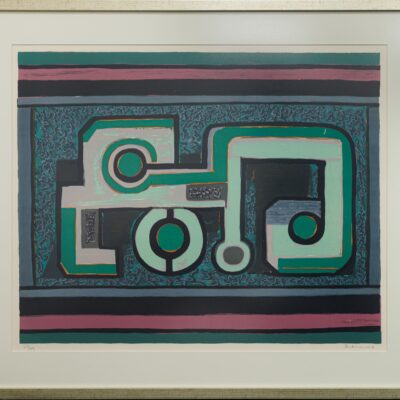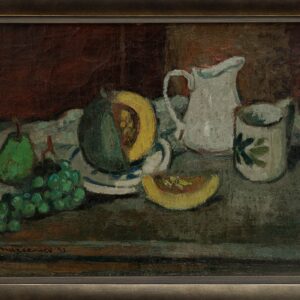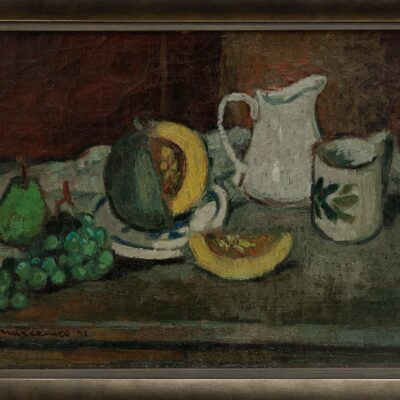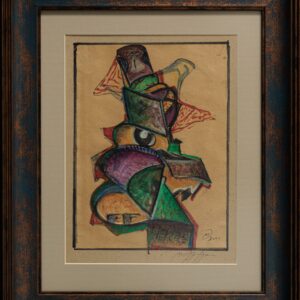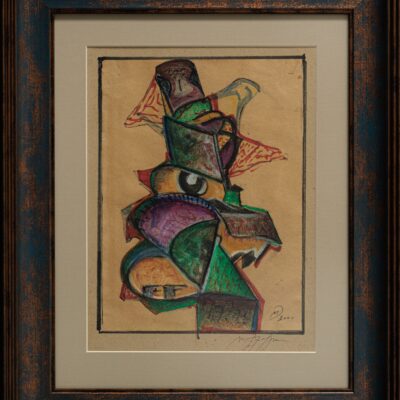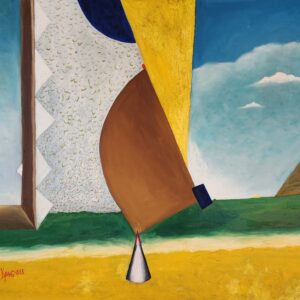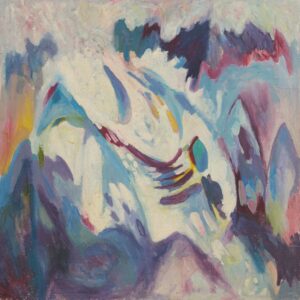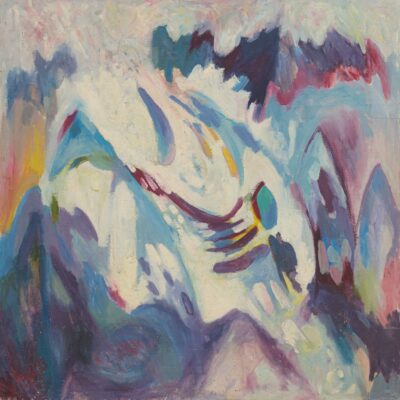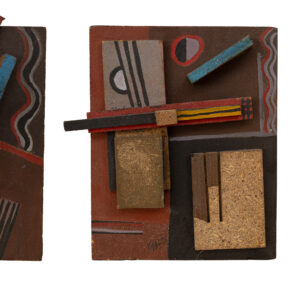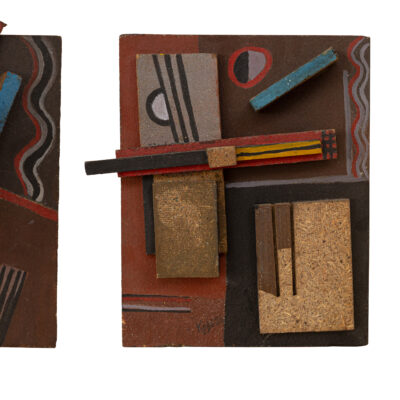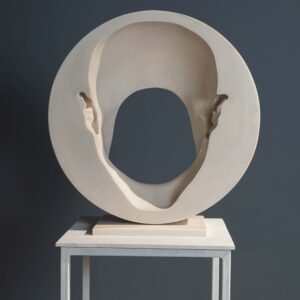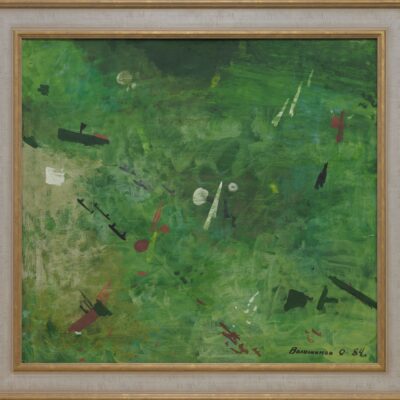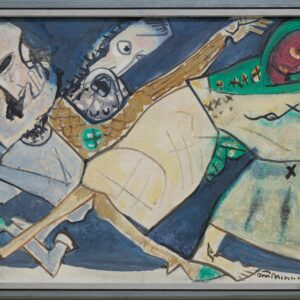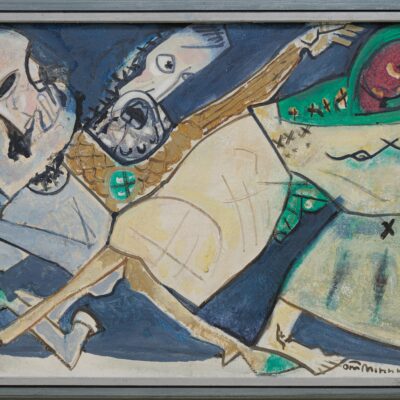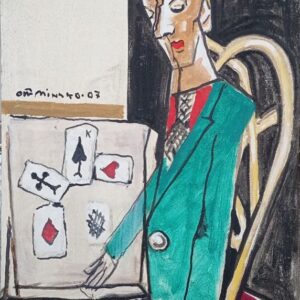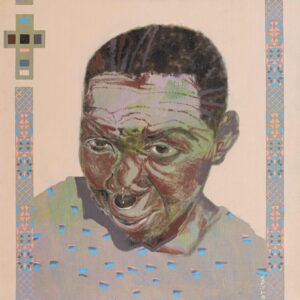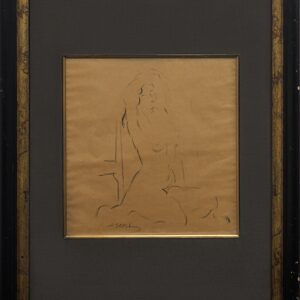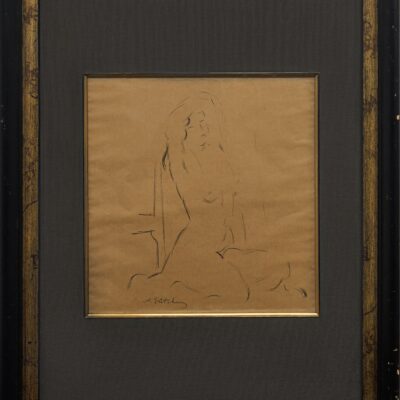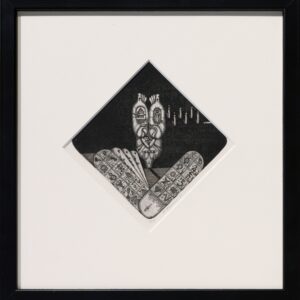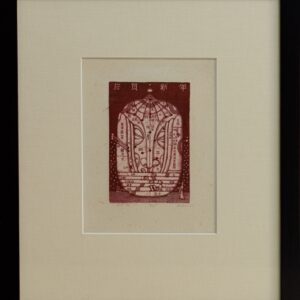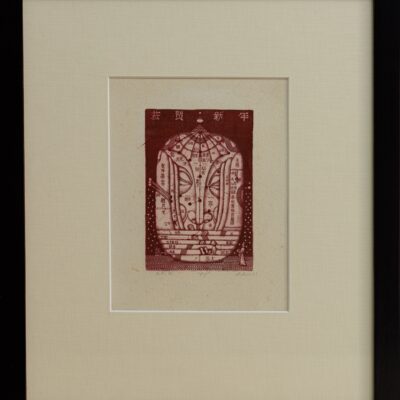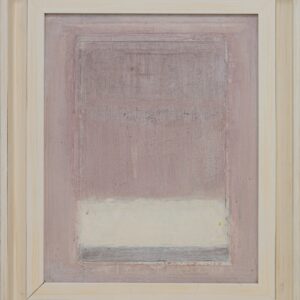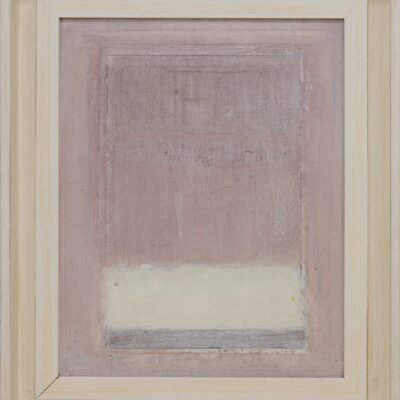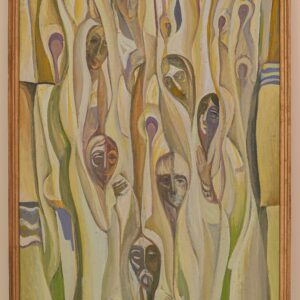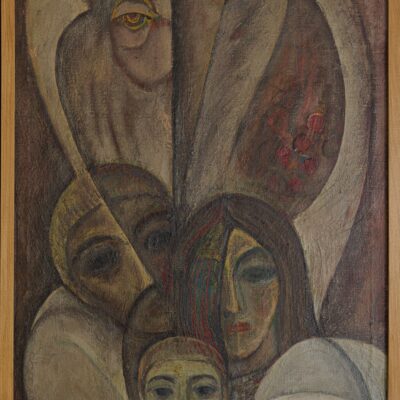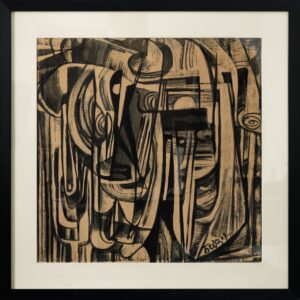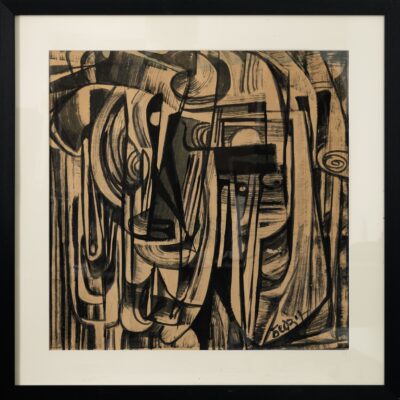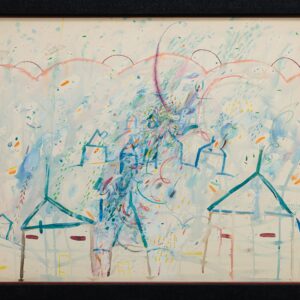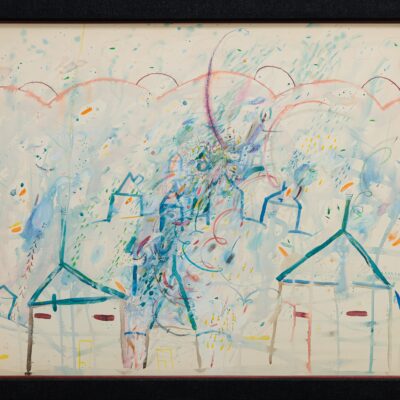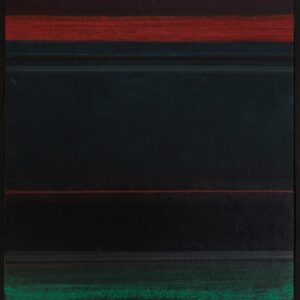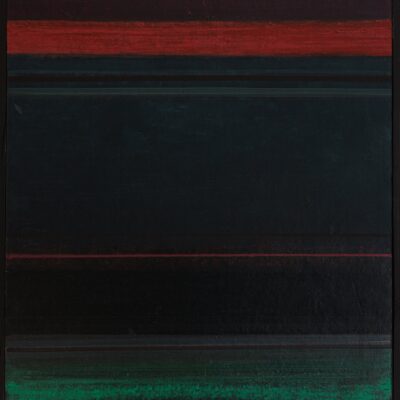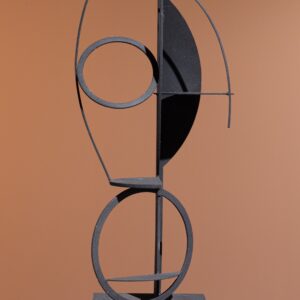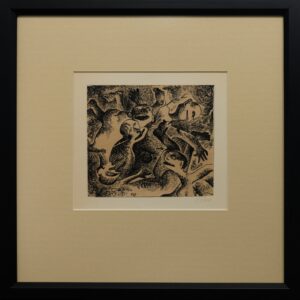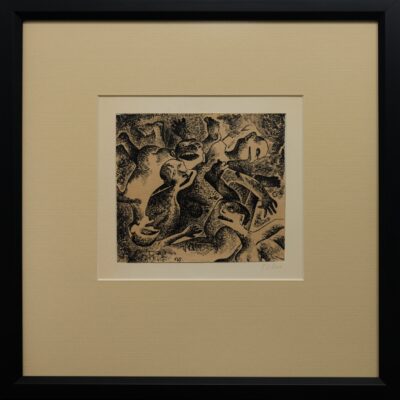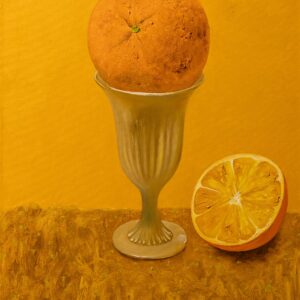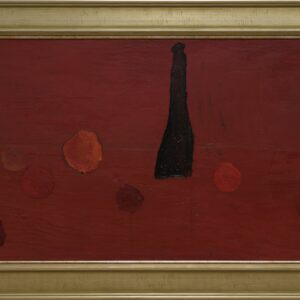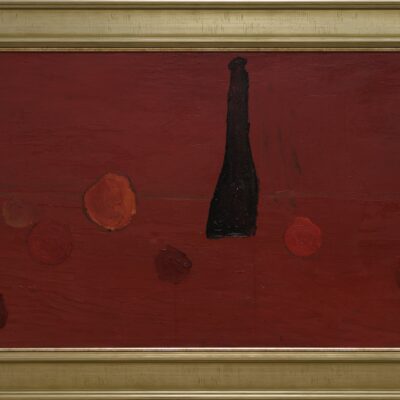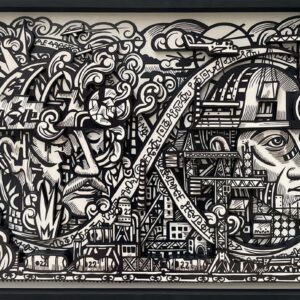Showing 41–80 of 91 results
Filters-
Ігор Подольчак «Памятник І», 1987
Starting bid 250$Ihor Podolchak (1962) is a Ukrainian postmodern artist, director, screenwriter, and curator. Addresses the spheres of installation, performance, and video art. The content of his works often combines pleasure and pain, love and play, forbidden desires, debauchery and sincere feelings. The works of Ihor Podolchak are stored in museums and private collections in Ukraine, France, Egypt, Australia, Great Britain, Israel, Germany, Norway, Poland, the USA, Bosnia and Herzegovina, Italy, Cuba, and Macedonia. In 1994, Podolchak represented Ukraine at the Art Biennial in Sao Paulo.
The artist often touches on social, political, and economic topics and satirizes society's flaws. Such is the graphic series "Monuments", where the author reflects on the change in worldview at the turn of the 80s and 90s. A post-apocalyptic composition with elements of decay tells about the loss of former landmarks. The faceless pedestal in the center, which gradually began to disintegrate, symbolizes the collapse of old values and the overthrow of former «heroes» who only hindered the country's development on the way to independence.
-
Ігор Подольчак «Полапка для дурня»
Starting bid 350$Ihor Podolchak (1962) is a Ukrainian postmodern artist, director, screenwriter, and curator. He works in the fields of installation, performance, and video art. His works often combine pleasure and pain, love and play, forbidden desires, debauchery, and sincere emotions. Podolchak’s graphics represent an important phase of Lviv’s alternative art of the second half of the 20th century. His style is distinguished by detailed compositions, a complex multi-layered visual language, and the use of symbols that challenge the viewer.
A Fool’s Trap explores the phenomenon of perception, societal control mechanisms, or internal limitations that a person creates for themselves. The composition is built on tension between space and forms that seem to balance between order and chaos. The visual elements interact in a way that creates a sense of uncertainty—a moment of entrapment that is not always recognizable.
The 1980s became a period for Podolchak to explore social mechanisms and psychological traps that influence human consciousness. His works from this time contain subtle irony, a critical view of society, and invite deeper reflection on the nature of choice.
-
Карло Звіринський «Зламане дерево», початок 1960-х
Starting bid 1800$Karlo Zvirynskyi (1923 – 1997) is a Ukrainian nonconformist artist, the founder of an underground academy in Lviv (1959-1966), whose methodology was based on reviving modernist artistic practices. In his works, he developed the idea of a syncretic world. With the help of various materials, he created tactile abstraction based on subconscious sensitivity and prayerful meditation. The artist's works are held in museums in Lviv, Kyiv, Khmelnytskyi, Wroclaw, New York, and Toronto, as well as in many private collections.
One of Karl Zvirynskyi's favorite subjects: is the thickets of the Carpathian forest, tree stumps, and "vorinnia" (wooden fences). He does not aspire to large-scale panoramic views, he focuses on details, looking for his images among fallen trees, branches, and uprooted stumps. It became a kind of escape for the artist, a way to abstract from the environment. -
Карло Звіринський “В лісі 6”, 1970-ті
Starting bid 2500$Karlo Zvirynskyi (1923 – 1997) is a Ukrainian nonconformist artist, the founder of an underground academy in Lviv (1959-1966), whose methodology was based on reviving modernist artistic practices. In his works, he developed the idea of a syncretic world. With the help of various materials, he created tactile abstraction based on subconscious sensitivity and prayerful meditation. The artist's works are held in museums in Lviv, Kyiv, Khmelnytskyi, Wroclaw, New York, and Toronto, as well as in many private collections.
In the works of Karl Zvirynskyi, the forest is a form of rest, meditation, and reflection. Zvirynskyi practices methods of avant-garde art. He admires the beauty of Ukrainian landscapes, experimenting with the effects of lighting and the plasticity of nature. The main thing in the work is color; the artist skillfully combines saturated bright colors to create a lyrical, emotional image of the Carpathians, with the help of which he reproduces his psychological state and inner desire for freedom.
-
Карло Звіринський «Крим 3»
Starting bid 11500$Karlo Zvirynskyi (1923-1997) — was a Ukrainian modernist artist and a reformer of art education. He was one of those who, during the totalitarian Soviet regime, managed to create a unique alternative art within the framework of late modernism. His work combines an in-depth study of ancient art, modern experiments, and spiritual syncretism expressed through abstraction.
The painting "Crimea 3" represents his transition to an abstract-expressive style. The composition is built on the interaction of color masses, tonal transitions, and dynamic forms, conveying the atmosphere of a place through inner perception. It is not a literal depiction of a landscape but rather a philosophical interpretation, where space is constructed through the interplay of light, shadow, and color.
The late 1950s marked a crucial stage in Zvirynskyi's artistic journey, during which he moved away from a naturalistic representation of nature in favor of its symbolic and emotional interpretation. During this period, he founded an underground school for young artists, known as "the "Zvirynskyi’s Underground Academy."". Його роботи цього періоду — це не просто пейзажі, а роздуми про структуру світу, взаємодію кольору та емоційного сприйняття.
-
Карло Звіринський «Ліс-VII»
Starting bid 2150$Karlo Zvirynskyi (1923-1997) — was a Ukrainian modernist artist and a reformer of art education. He was one of those who, during the totalitarian Soviet regime, managed to create a unique alternative art within the framework of late modernism. His work combines an in-depth study of ancient art, modern experiments, and spiritual syncretism expressed through abstraction.
The painting "Forest-VII" (1970s) reflects the key aspects of Karlo Zvirynskyi’s formal experiments: the interaction of light and shadow, dynamic lines, and a simplified interpretation of nature. By abandoning realistic details, the artist conveys not an illusion of reality but an emotional image of the forest—its vibrant colors and the rhythm of trees. This creates a symbolic space filled with both natural and metaphysical imagery.
In the 1970s, Zvirynskyi devoted considerable time to appliqué, a unique technique for formal experimentation, focusing on color, texture, and composition. His works from this period evoke a deep emotional response, affecting the viewer on a subconscious level.
This painting is a valuable example of the Ukrainian underground art movement, created under Soviet censorship. It is not only aesthetically significant but also serves as a cultural testament to the artist’s pursuit of freedom of expression, transcending the limits of traditional painting.
-
Леопольд Левицький «Бенкет»
Starting bid 520$Leopold Levytskyi (1906-1973) — was a renowned Ukrainian modernist artist, a prominent representative of the older generation of Lviv avant-garde and "Soviet modernism." He studied under the masters of Polish Secession at the Krakow Academy of Fine Arts, including W. Jarocki, K. Sichulski, F. Pautsch, and J. Mehoffer. Later, he was influenced by European avant-garde movements, working in the styles of Constructivism, Purism, and Expressionism. In the 1930s, he was a member of the left-wing radical avant-garde association "Krakow Group."
Levytskyi worked in the techniques of etching, drypoint, monotype, and linocut. In his early period, he created abstract plastic compositions. His style is distinguished by the simple, concise stylization of natural forms and an omnipresent rhythm. His works often featured themes of — social satire and witty grotesque.
The painting Banquet exemplifies Levytskyi's characteristic approach to stylization and formal simplification of multi-figure compositions. The work is structured through the rhythmic arrangement of silhouettes, creating an effect of chaotic yet structured movement. This scene serves as a metaphor for a society shaped by stereotypes.
The 1970s marked the crystallization of Levytskyi’s style. His works from this period, including Banquet, are defined by distinctive stylization, grotesque simplification of forms, and a deep social subtext. The painting is a significant example of Soviet modernism, blending artistic experimentation with social critique.
-
Мар’ян Олексяк Імпровізації, Із серії Мона Ліза, 2006
Starting bid 1000$Maryan Oleksiak (1959) is a Ukrainian artist who works in painting, graphics, photography, and assemblage. His work is dominated by the fragility of earthly existence and reflections on life after the apocalypse – hence the use of burnt objects and experiments with their texture. Among the materials he uses in his work are wires, cords, photographs, honeycombs, wood, hardboard, oil, chalk, metal, glass, glue, paper, and others. Maryan Oleksiak participates in Ukrainian and international exhibitions, mainly in Lviv, Drohobych, Wroclaw, Krakow, and Lublin. Participant of the "Srebrnu czworokąt" biennial in Przemyśl, Poland. The artist's works are kept in the museums of Lviv, Drohobych, and Ivano-Frankivsk.
Maryan Oleksiak thinks in metaphors; his work is full of ideas of deconstruction. In the "Mona Lisa" cycle, he continues to develop the theme of the impermanence of time, the loss of value orientations, decomposes the image into signs-symbols, and destroys the usual space. The picture is similar to an hourglass because the artist seeks to show how the world ages and that art can have a time dimension. The world is perishable and fragile, but there are things in it that are important to preserve.
-
Марина Скугарєва «25 серпня», 2021
Starting bid 3000$Maryna Skuhareva (March 2, 1962, Kyiv) is a Ukrainian artist representing the "New Wave". Skuhareva's artistic language is laconic, restrained, and full of symbols. The signature of most works is a small embroidered element. One of the main themes of creativity is a person and its adaptation to the environment. The works often have a feminist voice; the artist addresses the topics of sexuality, loneliness, and depression. Maryna Skugareva – has participated in many Ukrainian and foreign exhibitions. The artist's works are in museums and private collections in Ukraine, Denmark, and Switzerland.
"August 25" is a reflection on the Russian-Ukrainian war. Colorful saturated flowers contrast with the dark background, visualizing the artist's inner state. Flowers are associated with people. Plucked flowers symbolize death and destruction caused by war. Collecting them in a bouquet, the artist strives to preserve the memory of each innocent. Nearby, she embroiders a bird (the author's sign), associating it with the human soul, which has now forever gained peace and free flight.
-
Maria Prymachenko "Capercaillie singing a courting song", 1993
Starting bid 5000$Maria Prymachenko is a Ukrainian artist who represents naive painting. The author worked with gouache and watercolor and painted ceramics. Prymachenko developed her style – combining folk embroidery motifs, pysanka, and painting with Ukrainian mythology and folklore subjects. Prymachenko's creative method is an immersion in the collective subconscious of Ukrainians and the manifestation of archetypes imprinted in the Ukrainian worldview. The paintings of this artist are like the result of an eternal fairy tale about the attitude of Ukrainians toward the world: a model of nature and interaction with their animals and beasts. Her works surprised the world at exhibitions in France, Canada, Poland, Russia, Germany, Bulgaria, and other countries. The works are stored in the National Museum of Ukrainian Decorative Arts, the National Museum of Taras Shevchenko, and the Maria Prymachenko Family Foundation.
Prymachenko bravely drowned her canvases in bright colors; only her characters were filled with monotonous planes with rhythmic folk decorative ornaments. In Primachenko's paintings, strange zoomorphic creatures appear, often figments of her imagination. However, in the "Capercaillie singing a courting song", we can see a natural inhabitant of the Ukrainian fauna - the Western Capercaillie. The picture is painted in vivid spring colors because male capercaillies start their typical aria to attract the females in March-April. This work is about a simple and sensual spring love, which causes the desire to sing.
-
Микола Кривенко «Живопис епохи Тан», 2022
Starting bid 2800$Mykola Kryvenko (1950) is a Ukrainian artist, graphic designer, and master of bronze and wood figurative sculpture. Studying with the artist Hryhoriy Havrylenko in the 1970s and 1980s greatly influenced the formation of Krivenko's style. In the mid-1990s, he joined the Kyiv group of abstract painters, "Picturesque Reserve". Mykola Krivenko's style is often characterized as minimalistic. First, this concerns his ascetic palette in painting: pastel, natural tones, and sometimes wholly monochrome pieces. The author calls his art intuitive abstraction, where the idea, the inner state, and the source on which the method, composition, and color work are in the first place.
In the piece "Painting of the Tang Era", the deep meaning of observing nature is incorporated into its artistic technique, which repeats the texture of nature. Brush stroke after brush stroke, line after line, is formed in a whirlwind and turns into color-time, color-space, an unexpected and suddenly caught moment. The structure of the painting resembles the naive medieval painting of ancient Chinese masters on rice. The author leaves the viewer with the opportunity, with a little strain of imagination, to visualize the movement of the form outside the canvas. This is how he achieves an infinite spatiality greater than that in life.
-
Микола Кривенко «Вода і каміння», 2022
Starting bid 2800$Mykola Kryvenko (1950) is a Ukrainian artist, graphic designer, and master of bronze and wood figurative sculpture. Studying with the artist Hryhoriy Havrylenko in the 1970s and 1980s greatly influenced the formation of Krivenko's style. In the mid-1990s, he joined the Kyiv group of abstract painters, "Picturesque Reserve". Mykola Krivenko's style is often characterized as minimalistic. First, this concerns his ascetic palette in painting: pastel, natural tones, and sometimes wholly monochrome pieces. The author calls his art intuitive abstraction, where the idea, the inner state, and the source on which the method, composition, and color work are in the first place.
In the work "Water and Stones", the author immerses us in the space of his primary source of inspiration, where the element of water pulsates, lives, and moves. The forms and colors that Kryvenko reproduces here are more expressive, brighter, and clearer than in most of his works. He still shapes the painting world abstractly, but thanks to the minimal clarity of the images, he creates a feeling of direct contact with the living and interaction with nature, which disturbs, confuses, and fascinates the author.
-
Микола Трегуб «Політ на орбіту»
Starting bid 3500$Mykola Trehub (1943-1984) was a Ukrainian avant-garde artist and a key figure in Kyiv’s underground art scene of the 1970s. He worked in the fields of easel painting, graphics, installation, and conceptual objects.
At the core of the artist’s philosophy — was the contemplation of human existence in the context of complex circumstances. Mykola Trehub participated in informal and underground exhibitions, particularly those organized by the "Rukh" association. He was under constant surveillance by the KGB. One of his solo exhibitions was shut down before its official opening due to interference from the security services.
Flight into Orbit conveys the idea of movement, breakthrough, and stepping beyond the boundaries of the familiar space. The composition is filled with dynamics, rhythmic forms, and color contrasts, creating a sensation of flight and discovery. It reflects not only the technological progress of the space age but also humanity’s striving for knowledge and the expansion of personal horizons.
This work impresses with its bold visual language, deep symbolic richness, and sense of movement, making it multi-layered and open to individual interpretation.
-
Мирослав Ягода «Трава», 2016
Starting bid 7000$Myroslav Yagoda (1957 – 2018) is a Ukrainian artist and a prominent figure of the Lviv underground in the 1980s and 1990s. He worked in the fields of painting, graphics, and scenography. He was also engaged in poetry and drama. His work is characterized by a sharp reflection on reality, a tragic worldview, and an expressive psychedelic writing style. During his lifetime, he had about 17 personal exhibitions in Ukraine, Poland, and Austria. In 2019, a retrospective exhibition, «Myroslav Yagoda», was held at the Borys Voznytskyi National Art Gallery in Lviv. In 2020, the artist's works were exhibited in Kyiv at the National Art Museum in the "Я + GOD = A" exhibition.
Separated from society, Myroslav Yagoda turns his canvases into a kind of diary of the apocalypse, in which he reflects on momentary states of revelation and sudden emotional impulses. The artist's works are a kind of art therapy that deals with one's uncontrollable pain. The artist is not interested in the perishable; he seeks to depict the life of the spirit beyond the physical world. The characters of his paintings are unfortunate creatures who have faced horror. The viewer is afraid but, at the same time, empathizes with their pain. Such is the canvas "Grass". At first glance, the grass is associated with something calm and peaceful. However, we can never know what the tall, tangled stems hide or what danger may be hidden behind them. The same goes for a person, and it's emotions. Myroslav Yagoda thinks about the human subconscious, its alter-ego: about fears and experiences that can hide deep inside but at any moment come out.
-
Михайло Андрієнко-Нечитайло «Абстракція»
Starting bid 3800$Mykhailo Andriienko-Nechytailo (1894-1982) — was a world-renowned Ukrainian modernist and a prominent representative of the École de Paris. He worked in the field of experimental theatrical scenography in Odesa, Bucharest, Prague, and Paris. His artistic style encompassed avant-garde movements such as Cubism, Futurism, and Surrealism. His works are housed in museums in Paris (Centre Pompidou), London, Vienna, New York, and Rome.
Andriienko-Nechytailo was the first to introduce Cubo-Futurist aesthetics and optical illusion into European theater design. Many of his scenographic sketches are regarded by international critics as self-sufficient avant-garde works.
The painting "Abstraction" reflects the artist's experiments with the harmony of texture and color. The composition is structured in such a way that each element interacts with another, creating either tension or balance. The painting is perceived as a visual rhythm, dominated by the purity of lines and the intensity of color planes.
In the 1960s, Andriienko-Nechytailo merged early avant-garde influences with harmonious compositional solutions. His abstract works from this period exhibit a precise balance between form and color, giving them depth and expressiveness.
-
Михайло Андрієнко-Нечитайло «Абстракція»
Starting bid 500$Mykhailo Andriienko-Nechytailo — was a world-renowned Ukrainian modernist and a prominent representative of the École de Paris. He worked in the field of experimental theatrical scenography in Odesa, Bucharest, Prague, and Paris. His artistic style encompassed avant-garde movements such as Cubism, Futurism, and Surrealism. His works are housed in museums in Paris (Centre Pompidou), London, Vienna, New York, and Rome.
The painting "Abstraction" embodies his pursuit of purity of form and color balance. Geometric elements and subtle interactions of planes create a structured space filled with inner dynamics. The composition stands out for its rigor, conciseness, and refined rhythm.
The 1970s marked a period of deep exploration of abstraction for Andriienko-Nechytailo. His art from this time is a significant part of European modernism and the Ukrainian avant-garde.
This work captivates with its structural clarity and perfect balance of form and color. It not only reflects the aesthetics of modernism but also creates a sense of spatial equilibrium, resonating with the viewer on an intuitive level.
-
Михайло Андрієнко-Нечитайло «Натюрморт з динею»
Starting bid 5000$Mykhailo Andriienko-Nechytailo (1894-1982) was a world-renowned Ukrainian modernist and a prominent representative of the École de Paris. He worked in the field of experimental theatrical scenography in Odesa, Bucharest, Prague, and Paris. His artistic style encompassed avant-garde movements such as Cubism, Futurism, and Surrealism. His works are housed in museums in Paris (Centre Pompidou), London, Vienna, New York, and Rome.
"Still Life with Melon" Still Life with Melon demonstrates a masterful command of color and composition. The objects are arranged in a balanced equilibrium, while the color palette emphasizes their volume and texture. The melon, as the central element, draws attention with its shape and color, creating a sense of warmth and comfort. The composition is devoid of unnecessary details, giving it a sense of plastic clarity and aesthetic completeness.
The 1940s in his work became a period of searching for harmony in form, simplifying elements, and studying the interaction of objects in space. His still lifes combine traditional objectivity with a modernist vision, maintaining depth of perception and expressive composition.
This piece captivates with its harmonious structure, purity of form, and refined color, evoking a sense of tranquility and completeness.
-
Михайло Дзиндра «Абстракція»
Starting bid 750$Mykhailo Dzyndra (1921-2006) was a prominent master of modernist sculpture and a notable representative of the New York group of Ukrainian artists. During World War II, he studied at the Lviv School of Applied Arts under the guidance of Bohdan Mukhin and Ivan Severa. In 1944, he emigrated, living in Czechoslovakia, Germany, and the United States, where he developed his unique artistic style.
Dzyndra is considered an innovator in global sculpture of the second half of the 20th century: he introduced unique forms of organic abstraction and associative social imagery. He experimented with materials, creating landscape sculptures from construction mesh and cement.
The artwork "Abstraction" reflects the later stage of his creative journey, during which he focused on the interaction between space, material, and artistic idea. The composition is structured in a way that the form operates on the level of pure plasticity, creating a balance between order and improvisation. The dynamics of lines and volumes generate a sense of movement, transforming the piece into a multidimensional visual object.
-
Михайло Красник «Вітрила. Футуризм», 2015
Starting bid 1500$Mykhailo Krasnyk (1959) is a Ukrainian painter and graphic artist, one of the founders of semiotic abstraction in Ukrainian art. He creates his alphabet of "picturesque vibration" and disassembles the surrounding world into small elements and textures. For this, he uses the techniques of assemblage and tactile painting and creates unique graphics using blind embossing, stamps, and appliqué. Since the beginning of the 2000s, the artist has focused on metaphysical landscapes and their supremacist versions. The artist's works were presented at more than 300 international and all-Ukrainian exhibitions. He had personal exhibitions in Germany, Poland, the Netherlands, and Ukraine. His works are in 80 museums and galleries around the world.
The idea of deconstruction is embedded in The work "Vitryla. Futurism". The artist works with the category of memory, the imprint of time. There are no people in this picture, but it is about them, their feelings, a reflection of their worldview. The artist breaks down the familiar marine landscape into geometric figures and reduces them to a sign symbol. Seeks to convey rapid movement and energy. What happens on the canvas is one moment, a remembrance that will never happen again, remaining only an imprint of our memory.
-
Михайло Красник «Смуток»
Starting bid 2350$Mykhailo Krasnyk (1959) is a Ukrainian painter and graphic artist, one of the pioneers of semiotic abstraction and assemblage in Ukrainian art. His body of work includes experiments with folk art archetypes, landscapes, and metaphysical fantasies.
Krasnyk’s artistic path bypassed the academic school; instead, he was open to Western European visual culture through self-education. His style is distinguished by abstraction, the use of rhythmic repetition, geometrization of forms, and interaction with textures.
Sadness conveys a deep emotional experience through a restrained color palette, rhythmic forms, and spatial interaction. The work reflects an internal conflict or a moment of contemplation, where the interplay of colors and textures enhances the atmosphere of introspection and silence.
The late 1980s marked a period when Krasnyk mastered organic abstraction. His works became more emotionally saturated, exploring the theme of the human condition in nature, where elements of the landscape and emotional nuances of mood transition into abstract forms of painting.
-
Михайло Красник «Формальні експерименти»
Starting bid 1800$Mykhailo Krasnyk (1959) is a Ukrainian painter and graphic artist, one of the pioneers of semiotic abstraction and assemblage in Ukrainian art. His body of work includes experiments with folk art archetypes, landscapes, and metaphysical fantasies.
Krasnyk’s artistic path bypassed the academic school; instead, he was open to Western European visual culture through self-education. His style is distinguished by abstraction, the use of rhythmic repetition, geometrization of forms, and interaction with textures.
Formal Experiments demonstrates the artist’s deep interest in exploring form and its interaction with space. The work reflects an attempt to grasp the balance between chaos and order, where lines, planes, and color accents create a rhythmic visual flow. This piece not only examines compositional equilibrium but also invites viewers to engage in personal associations and interpretations.
The mid-1980s marked a period when Krasnyk actively experimented with abstract forms, striving to push beyond traditional perceptions of painting. This was a time of expanding artistic possibilities when unconventional visual solutions became a means of expressing new ideas. His works from this period are notable for their complexity, multilayered nature, and openness to diverse interpretations.
-
Назар Білик «Поглиблення», 2021
Starting bid 7000$Nazar Bilyk (1979) is a Ukrainian sculptor and author of objects for public space. His work explores the connection between person and nature and the environment. He strives to give visual embodiment not to the object but to the space around it and works with a counter-form. Nazar Bilyk has participated in numerous Ukrainian and foreign exhibitions, particularly in Germany, Switzerland, Italy, Belgium, Denmark, France, the USA, China, etc. Winner of many competitions, triennials of sculptures, and festivals.
The sculpture "Deepening" continues the theme of thinking about space and its influence on personality. In the center, there is a distinct silhouette of the head and a heavy monolithic mass around which extraneous thoughts and views from outside put pressure on a person, trying to influence. Nazar Bilyk thinks about human freedom and independence from forced ideas. The artist intentionally does not give the work individual features, encouraging viewers to identify the image with themself.
-
Олег Волошинов «Морський бій»
Starting bid 1100$Oleh Voloshynov (1936-2020) was a Ukrainian painter, an active participant in the Odesa nonconformist movement, and a member of the Odesa art group «Choven». He worked in the field of easel painting. His style balances between an expressive painterly form and lyrical abstraction.
The painting Naval Battle conveys a sense of struggle between warships through the interaction of light and dark planes. Contrasting colors, rhythmic lines, and active textures create the effect of a chaotic confrontation, reminiscent of the explosive energy of waves or the clash of forces.
This period in Voloshynov’s artistic career was dedicated to exploring energy and its interaction with space. His works are distinguished by drama, a contrasting palette, and deep symbolism, making them emotionally intense and open to interpretation.
This piece draws attention with its dynamism and expression. It conveys the feeling of an uncontrollable force, embodying the struggle of natural elements or human emotions. The composition immerses the viewer in the tension of the moment, leaving room for individual perception and reflection on the internal conflict unfolding on the canvas.
-
Олег Мінько «Бій кентаврів»
Starting bid 2200$Oleh Minko (1938–2013) was a Ukrainian nonconformist artist and a representative of "hermetic" art. He created images with dual meanings, using the symbolism of objects and human gestures to convey the theme of his work. The stylistics of his paintings reveal the influence of ancient Ukrainian iconography as well as European modernists such as Picasso, Braque, and de Chirico.
Minko's works are housed in national museums of Ukraine and in private collections both in Ukraine and abroad. The artist held solo exhibitions in London, Helsinki, Brussels, Copenhagen, Washington, and Vilnius.
The painting "Battle of the Centaurs" (1997) transports the viewer into the world of mythology, where the struggle takes on a universal symbolic meaning. The composition is filled with the energy of movement, the intertwining of figures, and the contrasting combination of colors, enhancing the dramatic intensity of the scene. The artist conveys not only a physical struggle but also a spiritual conflict—a clash of forces that extends beyond a specific plot and acquires a metaphorical significance.
The late 1990s in Minko's work marked a period of deep philosophical generalizations, focusing on themes of confrontation and harmony. His works from this time exhibit a synthesis of decorativeness and expression, where mythological images serve as a means of conveying the eternal themes of human existence.
-
Олег Мінько «Гра в карти», 2007
Starting bid 2500$Oleh Minko (1938 – 2013) is a Ukrainian nonconformist artist, a representative of «hermetic» art. He created images with a double meaning, where he narrated the theme of the work through the symbols of objects and human gestures. In the style of paintings, the influence of ancient Ukrainian icon painting and European modernists P. Picasso, J. Bracca, and J. De Chirico is felt. The works of Oleh Minko are kept in the state museums of Ukraine and private collections in Ukraine and abroad. The artist had personal exhibitions in London, Helsinki, Brussels, Copenhagen, Washington, and Vilnius.
The quintessence of the late period of Oleh Minko's creativity is a reassessment of values, reflections on society's flaws, and man's tragic fate in the 20th century. "The Card Game" is a work of that time. The artist symbolically divides the composition into two parts: collective and personal. The picture encourages critical thinking: personal is always colorful and comfortable; society, on the other hand, is like a card game: it has its dangers and a constant choice of priorities.
-
Олег Тістол «Маконде», 2001
Starting bid 3000$Oleg Tistol (1960, Mykolaiv region) is a Ukrainian postmodern artist and one of the leaders of the Kyiv association "Natsprom". Works in the fields of painting, installation, graphics, and sculpture. Critics attribute his work to the "Volitional edge of national post-eclecticism", the essence of which is rethinking aesthetic, socio-political stereotypes. He positions his work as "Ukrainian neo-baroque". With characteristic postmodern irony, he exposes the flaws of the colonial past. The artist works in series, each of which represents a certain image symbol. Tistol represented Ukraine at the 22nd Biennale in Sao Paulo (1994) and the Venice Biennale (2001). Oleg Tistol is a participant in numerous Ukrainian and international exhibitions. The artist's works are kept in private collections in Switzerland, Great Britain, Denmark, Germany, Norway, Finland, and Ukraine.
The work «Makonde» is part of the "National Geography" series, in which Oleg Tistol talks about the stereotypical perception of nationalities and nations set by the mass media. The artist uses clippings from old newspapers and magazines and creates collages of the same type- in the center is a typical portrait of a person of one or another nationality, framed by a clichéd ornament. In this way, the artist points out that the mass media distorts our ideas about other nationalities and raises the issue of authenticity.
-
Олекса Грищенко «Ню»
Starting bid 1400$Oleksa Hryshchenko (1883-1977) was a Ukrainian artist and art theorist, one of the prominent figures of the Paris School with worldwide recognition. A student of Kyiv landscape painter Serhii Sviatoslavskyi, he caught the attention of Fernand Léger, who was the first in France to acknowledge his work. In 1931, he became a member of the Salon d'Automne in Paris. Fascinated by contemporary painting, particularly Cubism, he traveled extensively in France and Italy. Since 1921, he had lived and worked in Paris, gradually moving away from Cubism toward Expressionism.
The painting "Nude" created in 1927, showcases his unique approach to depicting the human body. The female figure is not presented as an academic study but as a plastic image infused with the energy of line and form. Simplified contours, a rich color palette, and a well-structured composition create a sense of movement, emphasizing the vitality and power of corporeality.
The 1920s were a pivotal period in the formation of Hryshchenko's signature style, during which he actively experimented with new plastic solutions. His works from this time combine Impressionist sensitivity with avant-garde expression, making them significant within the context of European modernism.
This painting stands out for its expressive plasticity, Hryshchenko's refined artistic signature, and emotional intensity.
-
Oleksandr Aksinin "Cards", 1982
Starting bid 300$Oleksandr Aksinin (1949 – 1985) is a Ukrainian graphic artist and an iconic figure of the Lviv underground in the 1970s. He created the trend of "hermetic graphics" based on the East's philosophical systems and esoteric teachings. The artist paid particular attention to symbolic systems, thanks to which he created his style of illustrations. In that way, he showed contempt for the social order of the Soviet Union. Created a new graphic language as a reflection of his worldview. Since 2015, the artist's etchings from the "Boschiana" series have been exhibited in the collection of the Hieronymus Bosch Art Center in Hertonenbos, Netherlands. Three bookplates were presented to Pope John Paul II. After that, the graphic works of Alexander Aksinin gained popularity and were exhibited in Germany, France, Belgium, the USA, and other countries. The artist also held personal exhibitions in Tallinn, Lodz, Warsaw, Malbork, and Lviv.
"Cards" 1982 hides the theme of cosmogony; the artist turns to the theme of "zodiac signs" and "heavenly hierarchies". The work contains many minimalist signs and symbols, requiring a long meditative contemplation. Oleksandr Aksinin reflects on the place of humans in the universe and their connection with the cosmos.
-
Олександр Аксінін «Лик Будди»
Starting bid 450$Oleksandr Aksinin (1949-1985) — was a Ukrainian graphic artist, often referred to as the "Lviv Dürer" for his masterful command of etching techniques. His works are distinguished by complex multi-layered structures, symbolism, and philosophical depth. He combined the precision of graphics with metaphysical themes, creating works that are not only visually striking but also conceptually profound.
His style is based on precise geometry, a masterful balance of light and shadow, and hidden symbolic systems. Aksinin’s works resemble visual puzzles, where each element carries deeper meaning, inviting the viewer to contemplate. His art transcends traditional graphics, approaching a philosophical exploration of reality.
"Face of Buddha" — is a meditation on harmony, balance, and silence. The image of Buddha is not merely a sacred symbol but an idea of inner peace and deep contemplation. The composition creates a meditative immersion effect, where delicate lines and textural gradations evoke a sense of eternity and boundlessness.
The mid-1980s marked Aksinin’s period of engagement with spiritual and mystical themes. His works from this time serve as visual meditations, transporting the viewer into a space of deep symbolic reflection.
-
Олександр Стовбур «Медитація»
Starting bid 850$Oleksandr Stovbur (1943-2019) — is a Ukrainian artist, a master of abstract minimalism, and one of the leading figures of the Odesa nonconformist movement. In the 1970s, he joined a group of young artists working in an informal direction. He worked in painting, monumental art, and graphics. His work combines strict form, concise composition, and deep philosophical meaning. Color and structure serve as tools for meditative contemplation.
Meditation conveys a sense of inner focus and balance. The composition creates an atmosphere of silence and rhythm, where simple forms and nuanced color transitions generate an effect of harmony and contemplation.
The early 21st century became a period of deeper exploration of themes of tranquility and inner balance. During this time, the artist increasingly turned to minimalist forms, using them to convey profound emotions and cultural traditions.
The painting evokes a feeling of peace and equilibrium. The harmony of form and color makes it both universal and profound, while the minimalist composition allows space for personal interpretations.
-
Опанас Заливаха «Бруньки», 1997
Starting bid 5000$Opanas Zalyvakha (1925 - 2007) is a Ukrainian artist, dissident of the Ukrainian Sixtiers movement. The artist's creative language is simple but deep and meaningful. The artist skillfully synthesizes Ukrainian artistic traditions with individual approaches. Zalyvakha comprehends the most challenging categories: the essence of human life, freedom, the eternal search for truth, and rebellion against the system. In his art, he raised the issue of forced resettlement of people, cultural expansion, and the genocide of the Ukrainians in the USSR. He was imprisoned for 5 years for "anti-Soviet agitation and propaganda" in a camp in Mordovia, Russia. In 1995, Opanas Zalivakha was awarded the highest state award of Ukraine for developing culture and art - the Taras Shevchenko National Award. The artist's works were exhibited in Ukraine, the USA, Canada and Europe.
The artist reflects on Ukrainian folklore, seeks to find an answer to the question "Who are we?" and finds Ukrainian identity in its reinterpretation. The painting "Buds" is reminiscent of ancient plant ornaments, which our Ukrainian ancestors often used in embroideries or carpets. Opanas Zalyvakha contemplates nature and its colors. The entire canvas space is filled with abundant shoots, but instead of buds, we see the faces of people of different ages. Rhythmically stretching upwards, they appeal to the viewer, encouraging him to find his roots and understand his history.
-
Опанас Заливаха «Сім’я»
Starting bid 5650$Opanas Zalyvakha (1925-2007) was a Ukrainian artist of the Sixtiers movement, who combined symbolism, expression, and deep humanistic meaning in his work. His art is closely connected to national culture, the theme of freedom, and spiritual resilience. He worked in painting, graphics, and monumental art, creating works that carry a strong ideological message.
His style is distinguished by generalized forms, precise lines, and profound symbolism. His works always contain a philosophical subtext, touching on both personal and collective experience, particularly Ukrainian history and culture.
The painting Family reflects the idea of unity, mutual support, and inner strength. The composition is structured in a way that each element emphasizes the connection between the figures, creating a sense of protection, trust, and spiritual integrity. The visual language of the piece is restrained yet filled with deep emotional intensity.
The early 1970s was a period of persecution for Zalyvakha, which simultaneously tempered him as an artist and individual. His works from this time are characterized by symbolism, expressiveness, and internal tension.
This work captures attention with its emotional depth, symbolic power, and ability to convey an invisible but tangible connection between people.
-
Павло Бедзір «Маски в лісі»
Starting bid 1800$Pavlo Bedzir (1926-2002) was a Ukrainian artist, painter, and graphic artist, one of the leaders of the artistic underground in Zakarpattia. He began his artistic journey with realistic painting and drawing, later transitioning to graphic symbolism, abstraction, and mystical imagery. His work combines complex rhythmic compositions, archetypal symbols, and philosophical depth.
The painting "Masks in the Forest" conveys the dynamics of time, a sense of change, and spiritual searching. The composition is built on the interaction of graphic elements that create an effect of movement, cyclicality, and inner tension. The visual language of the work resonates with the ideas of an era when art transcended traditional forms, exploring the connections between space, time, and human consciousness.
This period in Bedzir’s artistic career was marked by experimentation and the rethinking of art as a meditative process. His works are distinguished by their multilayered nature and deep symbolism, making them significant in the context of Ukrainian modernism.
-
Павло Керестей «Без назви»
Starting bid 3900$Pavlo Kerestey (1962) is a Ukrainian painter and a prominent representative of the "New Wave" movement in Zakarpattia. He is known for his unconventional approach to form, content, and technique. He currently resides in Munich and Reading. His works in traditional genres often carry a deep philosophical subtext, exploring the boundaries between imagery and text, the real and the abstract.
In Kerestey's work, the idea of sensory interaction with reality plays a crucial role, manifesting through the interplay of forms, signs, and symbols. His style is distinguished by compositional freedom, fluid lines, and the use of ambiguous visual codes.
The painting "Untitled» resembles a winter landscape in terms of its composition, yet it also contains allusions to social and cultural contexts while reflecting the artist’s personal state during a period of transition and exploration.
The late 1980s was a time of global transformations that also influenced the artistic discourse. For Kerestey, this period was marked by a deepening exploration of painterly form, where experimentation became a means of expressing new ideas and pushing beyond the traditional understanding of imagery. This painting captivates with its conveyed sense of freedom, reflecting the spirit of an era of change and a profound philosophical subtext.
-
Павло Ковач «Стіна»
Starting bid 1100$Pavlo Kovach (1959) is a Ukrainian artist, curator, painter, graphic artist, and performer, a member of the "Pop-Trans" group. He is a co-founder of the "Koridor" gallery and the Pavlo Bedzir Museum-Workshop, whom he considers his mentor. He began exhibiting in 1984, and five years later, he presented his works at an international biennale. He is known for his experiments in painting, installation, and video performances.
Wall embodies the idea of an obstacle, division, or protection. The composition conveys a sense of solidity and immovability, yet at the same time, the potential for breakthrough or change. The surface of the work contains imprints of time, historical layers, or personal experience, making it rich in interpretation.
The contemporary period of Kovach’s work is marked by the exploration of physical and mental barriers, as well as the possibilities of overcoming them. His works investigate the boundaries of form and space, combining symbolism, texture, and depth.
This work attracts attention with its conceptual richness, strict form, and ability to evoke associations with limits and the potential to transcend them.
-
Петро Старух «Джаз», 2017
Starting bid 1000$Petro Starukh (1961) is a Ukrainian artist, musician, and writer, one of the founders of postmodern abstraction in Ukrainian sculpture. He often reproduces the state of political reality or invents his myths, which he embodies in wood, bronze, or stone. The sculptor breaks the structure of genres, encourages to go beyond the usual perception, and breaks established norms and barriers. The artist actively participates in performances, biennials, and international sculpture symposia. His works are kept in Lviv, Kyiv, Tokyo, Sydney, New York, Munich, and Rome collections.
Petro Starukh combines sculpture with music. The artist experiments with geometric shapes. Round, rotating elements change the usual perception of the sculpture, give it an unusual rhythmic sound, and smooth, soft lines are associated with free jazz improvisation.
-
Роман Жук «Весела компанія»
Starting bid 150$Roman Zhuk (1955) is a Ukrainian artist and one of the founders of Ukrainian transavant-garde. His works have been exhibited worldwide. He worked in the styles of metaphysical realism, surrealism, and symbolism, combining realistic techniques with fantastic and ironic narratives. Everyday images in his paintings take on deeper or even mysterious meanings.
Merry Company conveys an atmosphere of ease, but beneath its outward lightness, it may conceal social satire, an allegory of human relationships, or irony about the very concept of "merriment." The composition is built on the interaction of characters, creating tension in the scene and adding ambiguity to the imagery.
The early 1970s marked a period of active creative exploration for Zhuk, during which he experimented with blending the real and the imagined. His paintings from this time are characterized by deep emotional expressiveness, well-thought-out symbolism, and openness to multiple interpretations.
This work captivates with its delicate interplay of form, color, and meaning, compelling the viewer to examine details and uncover new meanings behind each image.
-
Роман Жук «Натюрморт з апельсинами», 2008
Starting bid 3000$Roman Zhuk (1955) – is a well-known figure of the Ukrainian trance avantgarde. He is an artist who reveals his vision and emotionality through images in moody still lifes, magical landscapes, portraits, and candid compositions. The painting style from the beginning of the 1980s is distinguished by the transformation of the traditional genres of still life and portraiture into mysterious stories that reflect life outside the boundaries of reality. Since the beginning of the 2000s, features of "cuteism" and hyperreality have been added to his works as metaphors for mocking the consumerist lifestyle. Roman Zhuk's works have been exhibited worldwide since 1987. The artist's works are in the collections of the Lviv Art Gallery, the Sumy Art Museum, the National Art Museum of Ukraine, the Museum of Modern Fine Arts of Ukraine, etc. Since the mid-1990s, the artist has been living in Amsterdam, Netherlands, but actively participates in the processes of Ukrainian art.
In "Still Life with Oranges", traditional still life is transformed into a narrative with quotations from the metaphysical painting of Giorgio Morandi. In the works of Roman Zhuk, quotations from European classics are often repeated: this is how he brings old truths into the modern context. Vulva materialized as frigid cold vases with oranges or bananas in paintings filled with saturated colours – one of these ideas. If we put aside the apparent obviousness and simplicity, the true nature of the author is revealed to us.
-
Роман Жук «Червоний натюрморт з пляшкою»
Starting bid 2000$Roman Zhuk (1955) is a Ukrainian artist and one of the founders of Ukrainian transavant-garde. His works have been exhibited worldwide. He worked in the styles of metaphysical realism, surrealism, and symbolism, combining realistic techniques with fantastic and ironic narratives. Everyday images in his paintings take on deeper or even mysterious meanings.
"Red Still Life with a Bottle" is built on subtle nuances of red tones. The artist forgoes traditional techniques of volume depiction in favor of the metaphysical significance of objects. The composition is simplified yet rich in subtext, prompting the viewer to contemplate the hidden relationships between the objects.
The late 1970s — marked the formation of Zhuk’s artistic language, when painting became an oasis of existential detachment for him. He actively explored still life as a genre, endowing it with new figurative qualities. During this period, he employed a minimalist approach to form and a deep color palette to create emotionally charged and conceptually layered images.
-
Roman Minin "Infinite Industry", 2022-2024
Starting bid 2500$Roman Minin (1981) is a Ukrainian artist and photographer who also works with sculptures, installations, and street art. Despite the traditionality of monumental art, the artist experiments with modern technologies: he works in the UV printing technique, creates NFT works, and dreams that artificial intelligence will continue to create works using his original technique. Minin's plots are about the reinterpretation of the identity of his home, Donbas, filling the region with positive meanings and the dream of future restoration and reconstruction - he embodies this through a wealth of symbols, graphic expressiveness, detail, and experiments with techniques. The artist participated in many group exhibitions and art festivals, organized the Street Art Festival in Kharkiv, and headed the "Isolation in Urban Space" program at the Donetsk Center for Contemporary Art "Isolation" in 2012. Minin's works were exhibited in key art spaces of Ukraine - from Mystetskyi Arsenal and Pinchuk Art Center to the Odesa Art Museum; they were sold at Phillips and Sotheby's auctions.
In the work "Infinite Industry", Minin feels to the smallest detail and immerses the viewer in the image of the Donetsk region stuck in history in the context of the eleventh year of the war, which does not leave this territory. This cardboard bas-relief features portraits of two men in a swirl of industrial markers, both projected as architectural structures and joined by an infinity symbol. The first in his circle of infinity is on fire, smoking; his protective helmet is broken, and military planes are flying overhead, tears in his eyes. The second is that the young structure is in a state of reconstruction. In this work, Donbas is stuck in the inextricable repetition of the "miner's paradise" between a terrible reality and a big dream.
